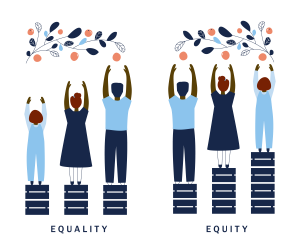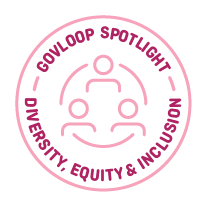What does government of the people, by the people and for the people look like in the 21st century and beyond? 
Fair and just — equitable — access to public services is the foundation of American democracy. Yet, deeply ingrained systematic disparities have led to racial gaps in housing, lending and employment opportunities, healthcare, military service, and access to higher education. These discrepancies prevent our country from acting as one united nation and pull our people apart, dividing communities across health, housing, education and technology lines.
What is the answer to solving these inequities? It starts with data, human-centered design and equitable listening.
Equitable listening is the backbone of leadership, from agency front lines to the C-suite and to every level within organizations. Seeking to understand the needs of those we serve is paramount. Great leaders connect dots so that people connect and support one another better. The ways that an agency communicates and fosters inclusivity aren’t just nice to have; they are a necessity.
It’s not possible to be a high-performing entity that delivers real mission outcomes without listening. With the current Biden-Harris administration in the White House and growing evidence that links adverse health outcomes to social determinants of health, the volume is being turned up on these issues with the executive orders on public equity and equity in the federal workforce.
 But what is equitable listening, anyway? We define equitable listening as the process of receiving, understanding and responding in a way that is fair, impartial and representative of those an organization or leader serves. Approaches and technologies grounded in human-centered design and journey mapping allow agencies to look at how people — employees and public recipients — experience public services. The models and standards built into agencies’ cultures help to determine the foundational internal work culture. Healthy work cultures drive the way public-facing goods and services are delivered.
But what is equitable listening, anyway? We define equitable listening as the process of receiving, understanding and responding in a way that is fair, impartial and representative of those an organization or leader serves. Approaches and technologies grounded in human-centered design and journey mapping allow agencies to look at how people — employees and public recipients — experience public services. The models and standards built into agencies’ cultures help to determine the foundational internal work culture. Healthy work cultures drive the way public-facing goods and services are delivered.
What does this look like in practice? Here are questions that all public sector leaders should be asking themselves and their agencies include:
- What does equitable listening mean for our agency and our mission outcomes? What best practices can we share across the public sector?
- How can we leverage human-centered design and data to eliminate injustices and patterns of bias?
- What does it look like to gather, analyze and respond to feedback in ways that are fair, impartial and representative of those they serve?
- How do we collect equity demographic data about the people we serve, including race, age, gender, ethnicity, socioeconomic status and geographic region, across every service we provide?
- How might we use data-driven analysis to redesign government services around user needs while implementing equitable approaches, backed by qualitative and quantitative data, testing, agility and continuous improvement?
To ensure a future where everyone’s voice is heard, understood and served with seamless government experiences, we must design and deliver all public services with empathy and compassion.
For additional guidance and resources on this important topic of equitable listening, check out the following to get a head start in planning for Democracy 2.0.
Customer and Employee Experience: Performance.gov makes it easier, through thoughtful writing and clear data visualizations, to understand the goals and outcomes the federal government is working to accomplish around customer experience, how it seeks to accomplish them and how agencies are performing. Trust in Public Service Act (TIPS) is bipartisan legislation designed to strengthen trust in the government by improving the customer experience of citizens and residents interacting with federal agencies, much of which draws from best practices to improve trust with the Veterans Affairs Department. Also, see White House Office of Management and Budget Circular No. A-11 and 21st Century IDEA Act, introduced to drive improvements in the digital experience for government customers and reinforce existing requirements for federal public websites.
Patient Experience: The 21st Century Cures Act (1.0 and 2.0 forthcoming) is designed to help accelerate medical product development and bring innovations and advances to patients who need them faster and more efficiently. This dovetails with future efforts to close health disparity gaps with supporting requirements noted in this act, including advancing interoperability and supporting the access, exchange and use of electronic health information.
Experience Enablement: OPEN Government Data Act is a bill that requires open government data assets made available by federal agencies (excluding the Government Accountability Office, the Federal Election Commission and certain other government entities) to be published as machine-readable data. For more on this topic, see evidence-based policymaking and Workforce Innovation Opportunity Act, which is landmark legislation designed to strengthen and improve our nation’s public workforce system. This aims to help get people, including youth and those with significant barriers to employment, into high-quality jobs and careers and help employers hire and retain skilled workers.
Interested in becoming a Featured Contributor? Email topics you’re interested in covering for GovLoop to featuredcontributors@govloop.com. And to read more from our summer/fall 2021 Cohort, here is a full list of every Featured Contributor during this cohort and a link to their stories.
Nina Bianchi focuses on transformative culture experiences. She served as Chief of People and Culture at the Food and Drug Administration (FDA) and with the General Services Administration’s (GSA) IT Modernization Centers of Excellence (COE). As a White House Presidential Innovation Fellow (PIF) with the Biden Cancer Moonshot at the National Cancer Institute (NCI), she led collaborative work experiences to drive personalized patient experiences. Before serving in government, Nina led a social innovation consulting firm with a network of high-impact public-private partnerships. Her teams designed transformation solutions for city governments across the globe, philanthropy, nonprofits, Fortune 500 companies and institutions like the Massachusetts Institute of Technology (MIT).






Leave a Reply
You must be logged in to post a comment.